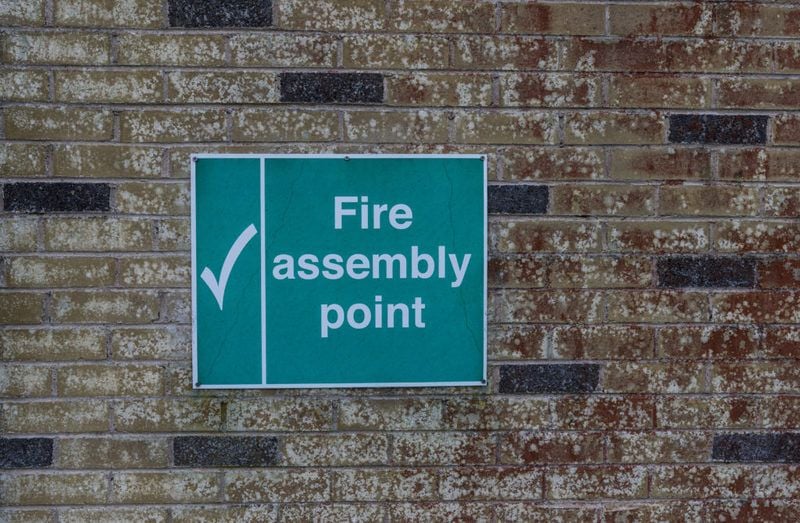When to Have Fire Drills in Your Workplace?
)
It is vital to have emergency response plans in the workplace that ensure all employees can get out of the building safely. Employees and employers have a number of things they need to make sure they know to be prepared for and properly deal with a fire at work. This is why we have Fire Drills.
Preparation is the key to an effective response to workplace fires. Fire drills and training help prepare employees to respond quickly, calmly, and safely. Fire drills play a very important role in workplace fire safety.
 The objectives of Fire Drills: Fire drills are not mere routine exercises; they are meticulously structured events designed to achieve several critical objectives:
The objectives of Fire Drills: Fire drills are not mere routine exercises; they are meticulously structured events designed to achieve several critical objectives:
1. Hands-on Practice: At its core, a fire drill offers employees a chance to physically practice emergency procedures. This practical experience is invaluable, as it ingrains the necessary steps for a safe and organized evacuation.
2. Assessing Competency: Fire drills also serve as an assessment tool for employers. They provide a tangible means of evaluating whether employees comprehend and can proficiently execute their designated emergency duties. This assessment ensures that each member of the workforce is not just aware of procedures but also capable of executing them under duress.
3. Evaluating Procedures: Beyond individual competency, fire drills offer an opportunity to assess the effectiveness of evacuation procedures. Observing how employees respond during these drills can uncover weaknesses in the existing plan, necessitating adjustments and improvements to enhance overall fire safety and evacuation strategies.
4. Regulatory Compliance: In many regions, conducting fire drills is not just a recommended practice but a legal requirement. Organizations must adhere to standards and regulations, such as the Australian Standard (AS) 3745-2010, which mandates the regular performance of fire drills. Compliance demonstrates a commitment to safety and the protection of both employees and assets.
Fire Drill Frequency: While the necessity of fire drills is clear, determining their frequency requires a more nuanced approach. The level of fire risk within a workplace plays a pivotal role in dictating how often these drills should occur. In workplaces characterized by serious fire hazards, such as industrial settings or facilities dealing with flammable materials, fire drills should ideally be conducted at least once every three months. In addition to regular fire drills, it is equally essential to incorporate evacuation exercises into the safety regimen.
Every department and area within the workplace should participate in at least one evacuation exercise annually. This holistic approach ensures that all employees, regardless of their location within the facility, are well-prepared to respond to fire emergencies effectively. Moreover, it may be necessary to appoint designated personnel responsible for overseeing evacuations during drills. These individuals should receive specialized training to effectively coordinate evacuations, provide guidance to employees, and ensure the safety of all involved.
Components of a Fire Drill: A well-structured fire drill consists of several critical components:
1. Activation of Alarms: The initiation of a fire drill begins with the activation of fire alarms or warning systems. This step simulates the start of a real fire emergency, alerting employees to take immediate action.
2. Notification: Employees must be adequately informed of the fire drill in advance. Notifications are typically made through announcements or visual cues, ensuring that participants are aware of the exercise.
3. Evacuation: The core of a fire drill lies in the evacuation process. All employees must promptly and orderly evacuate the building using designated escape routes. This phase assesses their ability to exit the premises safely and efficiently.
4. Assembly Points: Once outside, employees gather at predetermined assembly points, which are safe locations away from the building. This step is crucial for accountability, ensuring that everyone has safely evacuated and facilitating further communication and organization.
5. Evaluation and Feedback: Following the drill, a debriefing session is essential to assess the performance of employees. This includes analyzing the efficiency of the evacuation, identifying areas for improvement, and collecting valuable feedback from participants.
6. Documentation: Records of each fire drill must be meticulously maintained. These records include the date and time of the drill, the outcomes, and any identified areas for improvement. Proper documentation serves as evidence of compliance with safety regulations and helps guide the planning and execution of future drills.
Advantages of Regular Fire Drills: The benefits of conducting regular fire drills extend far beyond mere compliance. They include:
1. Heightened Safety Awareness: Employees become more attuned to fire hazards and safety procedures through regular exposure to fire drills, reducing the likelihood of accidents and injuries.
2. Faster Response Times: Frequent drills lead to quicker and more efficient employee responses during real emergencies, potentially saving lives and minimizing damage.
3. Enhanced Communication: Fire drills facilitate communication and coordination among employees, fostering a sense of teamwork during evacuations and emergency scenarios.
4. Demonstrated Commitment to Safety: Organizations that prioritize and conduct regular fire drills demonstrate a genuine commitment to safety and the well-being of their employees.
5. Risk Mitigation: Identifying and addressing weaknesses in evacuation procedures through drills minimizes the risk of potential disasters, reducing the potential impact on human lives and property.
6. Confidence Building: Employees who regularly participate in fire drills gain confidence and assurance in their ability to respond effectively during real emergencies, reducing panic and confusion.
In conclusion, fire drills are a linchpin of workplace safety, serving as a foundational element in ensuring the well-being of employees and the protection of valuable assets. Through systematic preparation and regular practice, organizations can foster a culture of safety, responsiveness, and resilience. Embracing the importance of fire drills is not just a legal obligation; it is a testament to an organization's unwavering commitment to safeguarding the lives and livelihoods of its workforce.

)
)
)
)
)
)
)
)
)
)
)
)
)
)
)
)
)
)
)
)
)
)
)
)
)
)
)
)






